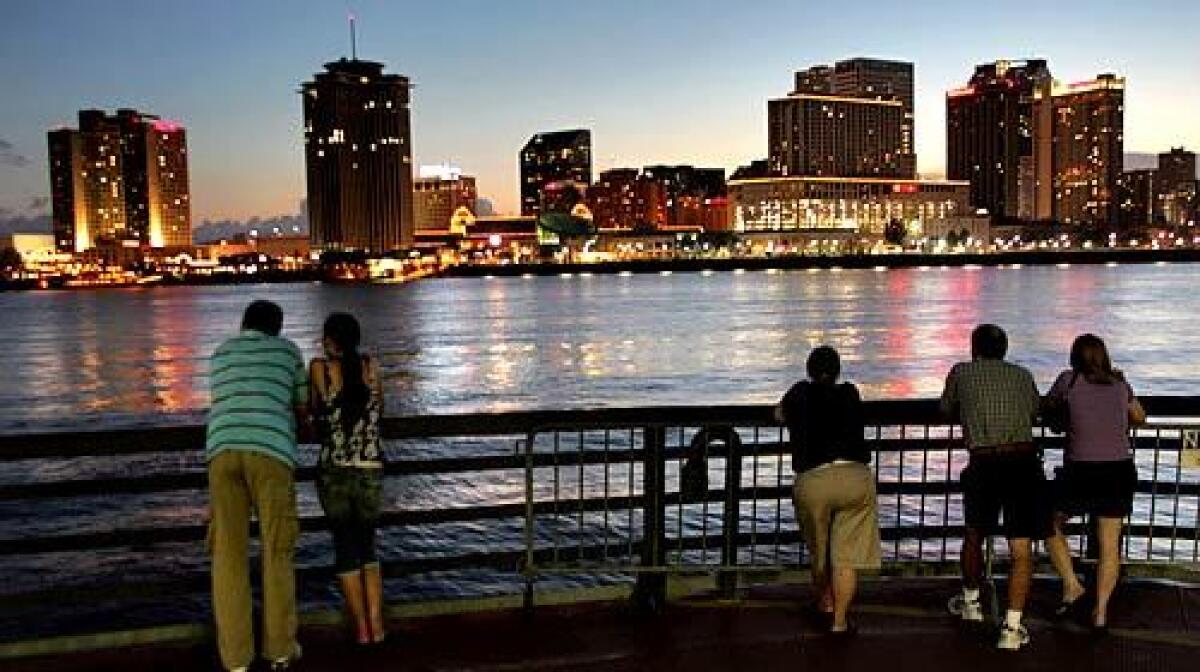Old city revels in a new spirit of innovation

- Share via
NEW ORLEANS — It’s difficult to nail down the last time this antique city was considered cutting edge.
Was it the 1850s, when a coffeehouse owner created the Sazerac cocktail? Or perhaps the 1940s, when a teenager named J.M. Lapeyre invented the automatic shrimp peeler?
Whatever the answer, New Orleans was not defined by its spirit of innovation in the decades preceding Hurricane Katrina. But the flood that changed everything two years ago has changed that too: Today, by accident and by necessity, this city is awash in ideas: the new and the ambitious, the au courant and avant-garde, the idealistic and the slightly nutty.
The New Orleans public education system, long considered one of most ineffective in the nation, has been revitalized with a grand experiment in charter schools; more than half of the city’s public campuses are charters, the highest percentage of any major metropolis.
The city housing authority hopes to transform the shuttered St. Bernard Projects, once one of its most notoriously violent properties, into something akin to a public-housing country club with two 18-hole championship golf courses and a 45,000-square-foot YMCA.
Environmental groups have swept into New Orleans, preaching a gospel of green building, solar power and other ideas familiar in Santa Cruz or Santa Monica but rather exotic here.
Local reformers have pushed for important changes to archaic government entities like the public defender’s office (each defendant is now assigned to one lawyer, not just to the office in general) and the tax assessor’s office (voters in November decided that the city needs one assessor, not seven).
Then there are the inventions. Elizabeth English, a Harvard-educated engineer and architect, is perfecting a method to retrofit shotgun houses with Styrofoam foundations. There will be fewer flooding problems, she figures, if the houses of New Orleans can float. “The old ways of doing things clearly haven’t worked,” said English, a professor at Louisiana State University.
English’s floating house concept lacks funding and the blessing of government. But hers is not the only long shot. No one guarantees that amateur inventor John Knost will ever see the groundbreaking for the flood wall he designed in his French Quarter apartment. Nor are city officials knocking down the doors of the San Francisco architectural firm that has proposed lining New Orleans’ shores with huge “sponge combs” -- caterpillar-like things filled with baby-diaper lining that would expand when wet to block surging floodwaters.
For some locals, however, it’s enough that the city is reveling in a new spirit of innovation.
Sean Cummings is a New Orleans native who is directing one of the most plausible big ideas for New Orleans -- a riverfront revitalization project sponsored by the city agency he heads, the New Orleans Building Corp. If Cummings has his way, the project could include a number of modern buildings that would soar beyond the city’s old architectural traditions.
Cummings believes that post-Katrina New Orleans has a chance to reconnect with the spirit of experimentation that defined it in the early 20th century, when Louis Armstrong and others were redefining music, and a Tulane-educated engineer named A. Baldwin Wood was inventing the pumps that would revolutionize modern flood control.
Back then, Cummings said, New Orleans “was an early adapter, a creator, a first.”
“Then, about 80 years ago, it became this very insular community,” he said. “And post-catastrophe, there’s a temptation, even a natural reaction, to recoil and fear the new. Well, quite honestly, that’s the medicine that this patient needs.”
Many of the people pushing for change here acknowledge that New Orleans -- with its economic problems, dysfunctional bureaucracies and recent reluctance to embrace change -- has a long way to go before it is seen as a reliable incubator of the new.
They also acknowledge that the most crucial innovation -- that is, guaranteed protection from a Category 5 hurricane with sustained winds of more than 155 mph -- has not been dreamed up, and perhaps never will be, despite renewed federal efforts to improve the city’s flood control system.
But they can also sound giddy that they have a shot to rethink a major American city from the ground up.
“Those of us working in bigger-picture stuff feel like we’re making the model not only for the country, but for almost the entire world,” said Elizabeth Teel Galante, local director for Global Green USA, a nonprofit that is building an environment-friendly affordable-housing project in the Lower 9th Ward.
“Sure, we could be wiped off the face of the Earth this fall,” she said. But in the meantime, she said, “We are focused on adapting.”
richard.fausset@latimes.com
More to Read
Sign up for Essential California
The most important California stories and recommendations in your inbox every morning.
You may occasionally receive promotional content from the Los Angeles Times.










